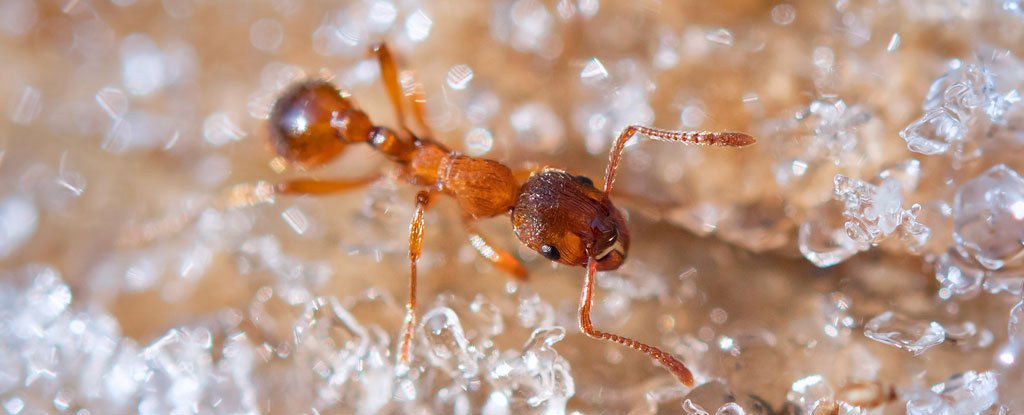Products You May Like
We humans are versatile and accomplished navigators, but insects might have navigation skills that are even better. For them, it’s literally a matter of life and death – and that’s why we decided to freeze some ants and beetles (don’t worry, they still survived) to learn more about how they remember their way home after an outing.
Their skills are pretty impressive. Ants living in the Saharan salt pans can travel for more than a kilometer, knowing at all times their location in relation to their nest. There are no landmarks or other features in that terrain to help the ants recognize where they are.
Instead, similar to the great explorers, such as Christopher Columbus and Ferdinand Magellan, the ants use the Sun’s position on the sky as a compass and their own motion to estimate distances. If you know the direction and distance you have walked away from home, you can draw a line pointing back to it. This allows the ants to safely return home after finding food.
To give some perspective on what these remarkable insects do, consider that 1 kilometer is about 100,000 times the body length of an ant. That is equivalent to a human walking from New York to Washington, DC, and then back, knowing at all times the correct direction and how far they have to go without using landmarks.
We wanted to learn more about how they do it.
Inside the insect brain
Thanks to recent developments in microscopy and genetics, scientists have been able to make different brain cells emit different colors of light.
This huge achievement allowed researchers to distinguish individual neurons and untangle how they connect to each other in the neural spaghetti that makes up the brain.
The technique has been used to see how an insect’s brain keeps track of its direction – and identify brain cells that encode an insect’s speed while it moves.
With that information, its brain can compute how far it has traveled by constantly adding its current speed to its memory during the trip.
Both the direction and distance traveled by the insect are encoded by neurons in its brain as it travels away from its nest. But how is this stored in their memory so they can find their way back?
Investigating memory
To be honest, it was quite a puzzling conundrum. The fast-moving navigating insects need to update their memory of direction and distance constantly on the fly, and yet can remember it for several days.
These two aspects of memory – fast updating and long lasting – are typically considered incompatible, yet insects seem to manage to combine them.
We set out to investigate exactly how insects manage to remember constantly updating memories over a long period of time – and, we decided that freezing the insects was the best way to find the answer.
Sounds strange I know, but let me explain why.
Anaesthesiologists know that when someone goes under anesthesia they forget certain things that happened before anesthesia, but remember others, depending on how these memories are stored.
The closest thing to anesthesia for insects is cooling them down. When their temperature is reduced to melting ice temperature (0 ºC), electrical activity in the brain stops, and the insects fall into a coma.
If their direction and distance memories are maintained as short-term electrical activity, they will be wiped out when they are frozen – but if they are stored in synapses between neurons (as long-lasting memories) they will be maintained.
So, we captured ants and beetles when away from their nests and cooled them down to melting ice temperature (0 ºC) for 30 minutes. Then we returned them to ambient temperature and, once they recovered, we released them at an unfamiliar place to see what they would do.
Typically, when these insects are released at an unfamiliar place in their home environment they would run straight towards where their nest would have been had they not been displaced.
That is they would run parallel to their normal path, and once they have traveled the expected distance they would start searching for their nest’s entrance.
But we found that the insects that had been frozen moved in the expected direction, but had forgotten the distance they should travel – this meant that they started searching for the entrance to their nest too early.
It was initially puzzling that the distance memory deteriorated while the direction memory was preserved – this result did not produce the clear-cut distinction between short-term (forgotten) and long-term (preserved) memory that we had expected.
But we think the best explanation for the phenomenon is not two separate memories, but one common memory that encodes both the direction and distance combined – and partially decays when frozen.
Here’s how we think it works.
Imagine that instead of remembering a distance and a direction (or angle), you remember your position in x-y coordinates, that is, the Cartesian coordinate system we learned about in school.
Then if you lose some of your memory, both your x and y values will be reduced, and assuming you lose a similar proportion of memory in both axes, you end up with a shorter distance but still the same angle, or direction.
It seems that insects have been using Cartesian coordinate systems to get home long before René Descartes formalized the concept. How cool is that?
Whether human or insect, we all need to return home. Learning how insect brains remember will help us to understand how we humans do it too.![]()
Ioannis Pisokas, PhD Candidate in Computational Neuroscience and BioRobotics, University of Edinburgh; Ajay Narendra, Senior Lecturer in School of Natural Sciences, Macquarie University, and Ayse Yilmaz-Heusinger, Postdoctoral researcher in Functional Zoology, Lund University.
This article is republished from The Conversation under a Creative Commons license. Read the original article.
